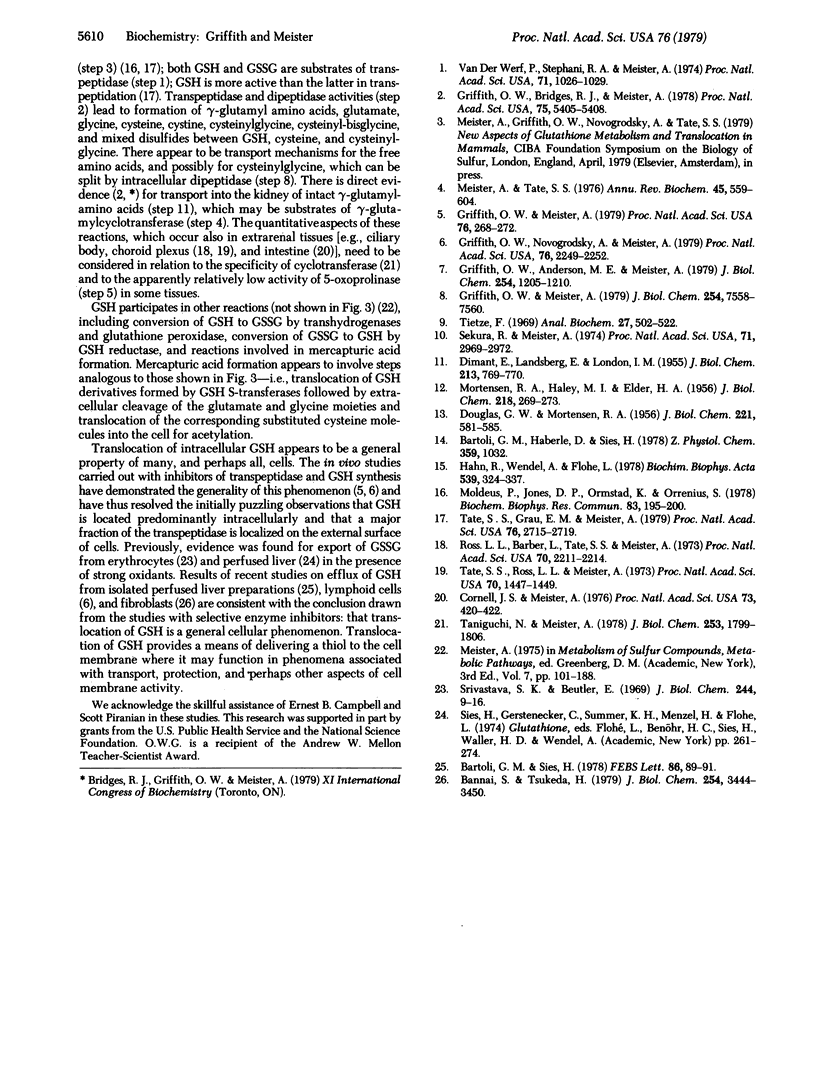Abstract
Glutathione is translocated out of cells; cells that have membrane-bound gamma-glutamyl transpeptidase can utilize translocated glutathione, whereas glutathione exported from cells that do not have appreciable transpeptidase enters the blood plasma. Glutathione is removed from the plasma by the kidney and other organs that have transpeptidase. Studies in which mice and rats were treated with buthionine sulfoximine, a selective and potent inhibitor of gamma-glutamylcysteine synthetase and therefore of glutathione synthesis, show that glutathione turns over at a significant rate in many tissues, especially kidney, liver, and pancreas; the rate of turnover in mouse skeletal muscle is about 60% of that in the kidney. Experiments on rats surgically deprived of one or both kidneys and treated with the gamma-glutamyl transpeptidase inhibitor D-gamma-glutamyl-(o-carboxy)phenylhydrazide establish that extrarenal gamma-glutamyl transpeptidase activity accounts for the utilization of about one-third of the total blood plasma glutathione. Normal animals treated with the transpeptidase inhibitor excrete large amounts of glutathione in their urine. They also excrete gamma-glutamylcysteine, suggesting that cleavage of glutathione at the cysteinylglycine bond may be of metabolic significance. The present and earlier findings lead to a tentative scheme (presented here) for the metabolism and translocation of glutathione, gamma-glutamyl amino acids, and related compounds.
Full text
PDF




Selected References
These references are in PubMed. This may not be the complete list of references from this article.
- Bannai S., Tsukeda H. The export of glutathione from human diploid cells in culture. J Biol Chem. 1979 May 10;254(9):3444–3450. [PubMed] [Google Scholar]
- Bartoli G. M., Sies H. Reduced and oxidized glutathione efflux from liver. FEBS Lett. 1978 Feb 1;86(1):89–91. doi: 10.1016/0014-5793(78)80105-7. [DOI] [PubMed] [Google Scholar]
- Cornell J. S., Meister A. Glutathione and gamma-glutamyl cycle enzymes in crypt and villus tip cells of rat jejunal mucosa. Proc Natl Acad Sci U S A. 1976 Feb;73(2):420–422. doi: 10.1073/pnas.73.2.420. [DOI] [PMC free article] [PubMed] [Google Scholar]
- DIMANT E., LANDSBERG E., LONDON I. M. The metabolic behavior of reduced glutathione in human and avian erythrocytes. J Biol Chem. 1955 Apr;213(2):769–776. [PubMed] [Google Scholar]
- DOUGLAS G. W., MORTENSEN R. A. The rate of metabolism of brain and liver glutathione in the rat studied with C14-glycine. J Biol Chem. 1956 Oct;222(2):581–585. [PubMed] [Google Scholar]
- Griffith O. W., Anderson M. E., Meister A. Inhibition of glutathione biosynthesis by prothionine sulfoximine (S-n-propyl homocysteine sulfoximine), a selective inhibitor of gamma-glutamylcysteine synthetase. J Biol Chem. 1979 Feb 25;254(4):1205–1210. [PubMed] [Google Scholar]
- Griffith O. W., Bridges R. J., Meister A. Evidence that the gamma-glutamyl cycle functions in vivo using intracellular glutathione: effects of amino acids and selective inhibition of enzymes. Proc Natl Acad Sci U S A. 1978 Nov;75(11):5405–5408. doi: 10.1073/pnas.75.11.5405. [DOI] [PMC free article] [PubMed] [Google Scholar]
- Griffith O. W., Meister A. Potent and specific inhibition of glutathione synthesis by buthionine sulfoximine (S-n-butyl homocysteine sulfoximine). J Biol Chem. 1979 Aug 25;254(16):7558–7560. [PubMed] [Google Scholar]
- Griffith O. W., Meister A. Translocation of intracellular glutathione to membrane-bound gamma-glutamyl transpeptidase as a discrete step in the gamma-glutamyl cycle: glutathionuria after inhibition of transpeptidase. Proc Natl Acad Sci U S A. 1979 Jan;76(1):268–272. doi: 10.1073/pnas.76.1.268. [DOI] [PMC free article] [PubMed] [Google Scholar]
- Griffith O. W., Novogrodsky A., Meister A. Translocation of glutathione from lymphoid cells that have markedly different gamma-glutamyl transpeptidase activities. Proc Natl Acad Sci U S A. 1979 May;76(5):2249–2252. doi: 10.1073/pnas.76.5.2249. [DOI] [PMC free article] [PubMed] [Google Scholar]
- Hahn R., Wendel A., Flohé L. The fate of extracellular glutathione in the rat. Biochim Biophys Acta. 1978 Mar 20;539(3):324–337. doi: 10.1016/0304-4165(78)90037-5. [DOI] [PubMed] [Google Scholar]
- MORTENSEN R. A., HALEY M. I., ELDER H. A. The turnover of erythrocyte glutathione in the rat. J Biol Chem. 1956 Jan;218(1):269–273. [PubMed] [Google Scholar]
- Meister A., Tate S. S. Glutathione and related gamma-glutamyl compounds: biosynthesis and utilization. Annu Rev Biochem. 1976;45:559–604. doi: 10.1146/annurev.bi.45.070176.003015. [DOI] [PubMed] [Google Scholar]
- Moldéus P., Jones D. P., Ormstad K., Orrenius S. Formation and metabolism of a glutathione-S-conjugate in isolated rat liver and kidney cells. Biochem Biophys Res Commun. 1978 Jul 14;83(1):195–200. doi: 10.1016/0006-291x(78)90416-3. [DOI] [PubMed] [Google Scholar]
- Ross L. L., Barber L., Tate S. S., Meister A. Enzymes of the gamma-glutamyl cycle in the ciliary body and lens. Proc Natl Acad Sci U S A. 1973 Aug;70(8):2211–2214. doi: 10.1073/pnas.70.8.2211. [DOI] [PMC free article] [PubMed] [Google Scholar]
- Sekura R., Meister A. Glutathione turnover in the kidney; considerations relating to the gamma-glutamyl cycle and the transport of amino acids. Proc Natl Acad Sci U S A. 1974 Aug;71(8):2969–2972. doi: 10.1073/pnas.71.8.2969. [DOI] [PMC free article] [PubMed] [Google Scholar]
- Srivastava S. K., Beutler E. The transport of oxidized glutathione from human erythrocytes. J Biol Chem. 1969 Jan 10;244(1):9–16. [PubMed] [Google Scholar]
- Taniguchi N., Meister A. gamma-Glutamyl cyclotransferase from rat kidney. Sulfhydryl groups and isolation of a stable form of the enzyme. J Biol Chem. 1978 Mar 25;253(6):1799–1806. [PubMed] [Google Scholar]
- Tate S. S., Grau E. M., Meister A. Conversion of glutathione to glutathione disulfide by cell membrane-bound oxidase activity. Proc Natl Acad Sci U S A. 1979 Jun;76(6):2715–2719. doi: 10.1073/pnas.76.6.2715. [DOI] [PMC free article] [PubMed] [Google Scholar]
- Tate S. S., Ross L. L., Meister A. The -glutamyl cycle in the choroid plexus: its possible function in amino acid transport. Proc Natl Acad Sci U S A. 1973 May;70(5):1447–1449. doi: 10.1073/pnas.70.5.1447. [DOI] [PMC free article] [PubMed] [Google Scholar]
- Tietze F. Enzymic method for quantitative determination of nanogram amounts of total and oxidized glutathione: applications to mammalian blood and other tissues. Anal Biochem. 1969 Mar;27(3):502–522. doi: 10.1016/0003-2697(69)90064-5. [DOI] [PubMed] [Google Scholar]
- Van Der Werf P., Stephani R. A., Meister A. Accumulation of 5-oxoproline in mouse tissues after inhibition of 5-oxoprolinase and administration of amino acids: evidence for function of the gamma-glutamyl cycle. Proc Natl Acad Sci U S A. 1974 Apr;71(4):1026–1029. doi: 10.1073/pnas.71.4.1026. [DOI] [PMC free article] [PubMed] [Google Scholar]


